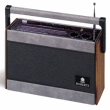Radio waves and sound waves are different.
To see how your radio station sends sound your way, click through this animation.
Begin Here: START ANIMATION  A sound wave is produced with a frequency of 5 Hz - 20 kHz. NEXT  |
 The sound wave is a pressure wave traveling through the air. |
 A microphone converts the sound wave into an electrical signal. NEXT  |
 The electrical wave traveling through the microphone wire is like the original sound wave. NEXT  |
 The electrical wave is used to modulate a high-frequency "carrier" radio wave. The carrier wave itself does not include any of the sound information until it has been modulated. NEXT  |
|
Your radio contains an antenna to detect the transmitted signal, a tuner to pick out the desired frequency, a demodulator to extract the original sound wave and an amplifier which sends the signal to the speakers. The speakers convert the electrical signal into physical vibrations (sound). |
  |
 The signal is transmitted by a radio broadcast tower.  NEXT NEXT |
  The carrier wave can either be amplitude modulated (AM, above) by the electrical signal, or frequency modulated (FM, below). |
|
RESET DIAGRAM
